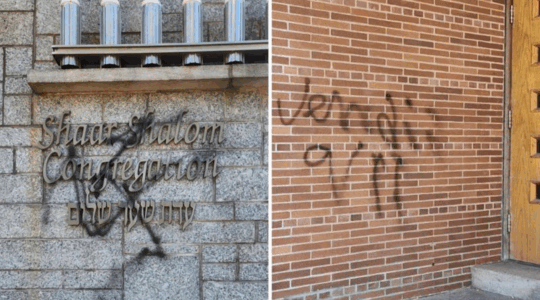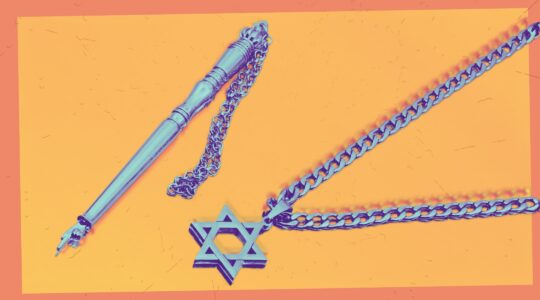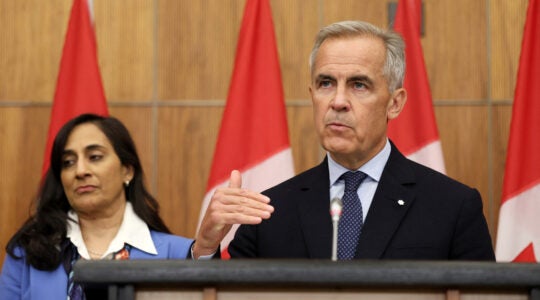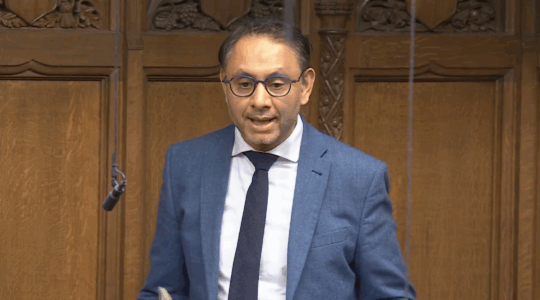SHANGHAI, China (JTA) — In Eastern Europe and the former Soviet Union, Western philanthropists and volunteers are restoring dozens of historic Jewish cemeteries.
But in Shanghai, there are none to restore.
The four cemeteries that once served this city’s small but prosperous Jewish community disappeared in the late 1960s during China’s Cultural Revolution. The sites were paved over to build a factory, park, hotel and Muslim cemetery, their history forgotten.
Israeli photojournalist Dvir Bar-Gal is trying to change that.
While the cemeteries may be gone, since 2001 Bar-Gal has made it his mission to track down as many of the original headstones as possible. He has located 85 and hopes to use them in a memorial to Shanghai’s Jewish past.
The project has kept Bar-Gal in Shanghai for more than seven years, and he is waiting for government permission to erect the memorial. The clock is ticking, he says.
“In a few years, the area where I found these stones will be gone,” Bar-Gal told JTA. “The villages I first visited have been redeveloped and are now upscale residences.”
Shanghai, a major port that is now China’s largest city, has had three waves of Jewish immigration. The first began in 1845, when David Sassoon, an Iraqi Jew living in India, moved his family business to Shanghai, which was China’s first city to open to the West. He was joined by two other Baghdad Jews, Elly Kadoorie and Silas Hardoon, and as the community grew they built Shanghai’s fortunes and their own.
After 1905, Russian Jews fleeing pogroms and revolution arrived in Shanghai. And in the 1930s, in the third wave, some 30,000 refugees from Nazi Europe arrived in the city when other countries were closing their doors to Jewish refugees. Shanghai, an “open city,” allowed immigration without visa or passport.
Japan occupied Shanghai in World War II but refused Nazi orders to deport or murder the city’s Jews. The 20,000 stateless Jewish refugees still in the city were confined in what became known as the Hongkew ghetto, but those with jobs outside were permitted to continue working. The Iraqi and Russian Jewish communities, along with the American Jewish Joint Distribution Committee, sent in frequent aid.
Disease and poverty were rampant, but the Jews of Shanghai were spared the horrors of the Holocaust. After the war, virtually all of them left for Hong Kong, Australia, North America and Israel.
Bar-Gal discovered this history in November 2001 during a Jewish tour of Shanghai led by fellow expatriate Georgia Noy. She told him that a local antiques dealer was selling two Jewish tombstones from one of the abandoned cemeteries.
What began as a mystery tale soon turned into an all-consuming project. Bar-Gal and Noy visited the dealer and purchased one of the headstones; the other already had been sold.
The first headstone led Bar-Gal to dozens more, which he hunted down in villages outside the city. Some were being used as stepping stones. Others were embedded in garden walls, used to build bridges or simply were thrown into rivers. Some village women used them as washboards, the letters worn away by years of scrubbing.
Funded in part by a grant from the Sino-Judaic Institute at Stanford University, Bar-Gal hired teams of workers to dig out the headstones from the strange places they had come to rest. In many cases he had to purchase them from villagers who claimed to own them.
Their inscriptions chronicle the history of Shanghai Jewry, from the 1874 headstone of a British sailor named Lazarus to the 1958 headstone of Charles Perceval Rakuzen, a British-born ophthalmologist whose sister still lives in England.
Bar-Gal set up a Web site with photos and information about the headstones he found, including interviews he conducted with surviving family members.
Twenty of the headstones found by Bar-Gal are being held by the government in a Buddhist cemetery while their fate is determined. Five others were too heavy to dig out. The 60 in his possession have been moved to four storage facilities over the years while Bar-Gal awaits government permission to build a Jewish memorial in a small park in the middle of the former ghetto. The park already contains a granite marker commemorating the Jews of the ghetto, and it is close to the recently restored Ohel Moshe Synagogue, which houses an exhibit of the city’s Jewish history.
“Tourists who care about the Jewish history of Shanghai come to this park, so it’s a natural place for such a memorial,” Bar-Gal said. “It would serve as a great bridge between Jewish and Chinese cultures while expressing the mutual hardship we shared in the dark days of World War II.”
The Israeli Consulate has added its voice to his pleas, but Bar-Gal has received just one response from the authorities.
“They said it’s bad luck to put gravestones in a park used by the living,” he said.
Bar-Gal now runs the tour of Jewish Shanghai formerly offered by Noy, who has left China. Quite often, he says, former ghetto residents show up on his tour. If they remember their wartime address he can usually locate their homes; the city has not changed the numbers on old buildings.
But Shanghai’s population of 26 million is growing rapidly, and the Hongkew neighborhood, including the 1.25-square-mile Jewish ghetto, is slated for redevelopment.
The district mayor agreed six years ago to stave off construction for a sum of $700 million, but despite initial interest by two Canadian benefactors, no buyers have come forward. Bar-Gal points out that $700 million would be used primarily to relocate the neighborhood’s 16,000 residents; much more would be needed to maintain the area as a tourist destination.
Meanwhile, Bar-Gal’s 60 headstones rest in a warehouse he shares with the Jewish Center.
“They are somewhere between the pickles and the Passover matzah,” he said.
JTA has documented Jewish history in real-time for over a century. Keep our journalism strong by joining us in supporting independent, award-winning reporting.





